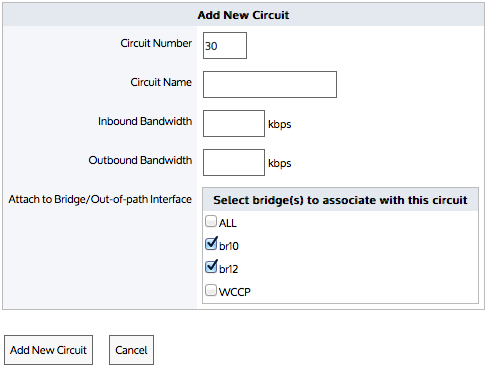Circuits
Circuits define physical connections to the WANWide Area Network/Internet. For appliances with more than one bridge configured, you can bind each bridge to a separate circuit or you can treat all bridges as one combined circuit. Typically, when the appliance is placed in line, one circuit would be created for each physical link.
When defining circuits, ensure each bridge is bound to a circuit; otherwise network traffic on any bridge that is not bound to a circuit, will not be affected by policy and will be monitored in a catch-all circuit.
NOTE
- For version 7.0.2 and earlier: A circuit can only be bound to one bridge, or all bridges (but not greater than 1 bridge and less than all bridges) or one WCCP interface.
- For version 7.0.2 Update 1 and later: A circuit can be bound to any number of bridges or one WCCP interface.

Circuit form for versions 7.0.2 and earlier

Circuit form for versions 7.0.2 Update 1 and later
Circuits are part of the policy tree. To learn how circuits, virtual circuits, and policies work together, see Policy Tree.
Can a bridge be bound to more than one circuit?
A bridge can be assigned to more than one circuit. Once a type of traffic matches a virtual circuitlogical definitions that partition a a physical network circuit and used to determine what traffic passes through it and how much and policy, it will not be processed by later circuits, virtual circuits, and policies. If the type of traffic does not match any policy in the first circuit, then it will attempt to match the policy in the second circuit.
For example, consider where circuits, virtual circuit, and policy are defined as:
- Circuit A = br10
- Virtual Circuit
- Policy for P2P
- Circuit B = All bridges
- Virtual Circuit
- Policy for Mail
In this case, br10 is assigned to both circuit A & B. However, br10 is bound to circuit A first.
- If the traffic is P2P, then that traffic type will be processed by Circuit A and will not be processed by Circuit B.
- If the traffic is mail, then that traffic type will not match Circuit A. It will attempt to match policy in Circuit B. In this case, it will match the policy for mail.
- If the traffic is not P2P or mail, then that traffic type will not match Circuit A or Circuit B and therefore will fall into an auto-catch-all circuit, auto-catch-all virtual circuit, and auto-catch-all policy.